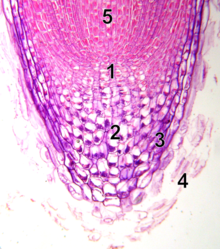
The root cap is a type of tissue at the tip of a plant root. It is also called calyptra. Root caps contain statocytes which are involved in gravity perception in plants. If the cap is carefully removed the root will grow randomly. The root cap protects the growing tip in plants. It secretes mucilage to ease the movement of the root through soil, and may also be involved in communication with the soil microbiota.
The purpose of the root cap is to enable downward growth of the root, with the root cap covering the sensitive tissue in the root. Thanks to the presence of statocytes, the root cap enables geoperception or gravitropism. This allows the plant to grow downwards (with gravity) or upwards (against gravity).
The root cap is absent in some parasitic plants and some aquatic plants, in which a sac-like structure called the root pocket may form instead.
References
- ^ Raven, J.A.; Edwards, D. (2001). "Roots: evolutionary origins and biogeochemical significance". Journal of Experimental Botany. 52 (90001): 381–401. doi:10.1093/jexbot/52.suppl_1.381. PMID 11326045.
- Burgess, Jeremy (1985-05-16). Introduction to Plant Cell Development. CUP Archive. ISBN 9780521316118.
- Kuya, Noriyuki; Sato, Seiichi (2011). "The relationship between profiles of plagiogravitropism and morphometry of columella cells during the development of lateral roots of Vigna angularis". Advances in Space Research. 47 (3): 553–562. Bibcode:2011AdSpR..47..553K. doi:10.1016/j.asr.2010.09.009.
- Jeffrey, Edward Charles (2007). The Anatomy of Woody Plants. Pomeroy, Ohio: Carpenter Press. ISBN 978-1-4067-1634-4.
- Gupta, P.K. (2007). Genetics: Classical to Modern. Rastogi Publications. ISBN 978-8-1713-3896-2.
This plant morphology article is a stub. You can help Misplaced Pages by expanding it. |